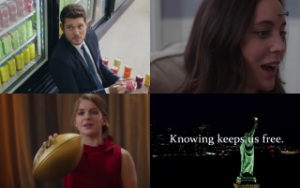Video holds powerful brand and advertising potential. We’re sharing our tips for crafting a cinematic marketing masterpiece that tells your story—and moves your viewer.
The use of video in marketing and advertising is well noted—a simple search will return a list of statistics proving its power, while a simple introspection is all that’s needed to reveal its effect on you. Sure, we’ve all heard that a picture is worth 1,000 words, but with Forrester Research claiming videos are worth 1.8 million, it’s time take a closer look.
The key is methodically maneuvering and capitalizing on every aspect of the video asset—from sound to imagery—to make sure it’s appealing to the viewer’s emotions in the way you want it to. As an example, you can see storytelling powers at play in this video we created for Nod. (WARNING: Extreme adorableness ahead.)
—Amazing video isn’t simply a sexier version of your website or brochure. It’s the precise combination of sights and sounds that move the viewer by telling a story. |
If you pay close attention, you can begin to dissect all the minute details and decisions that come together to tell Nod’s story: the soothing music layered with knowledgeable insights from interviewees, the twilight-hued frames of squirmy babies versus the bold lighting of the interviews, the fine-tuned timing of cuts between precious baby feet and the brilliant researchers behind Nod, and so on.
Of course, the average viewer isn’t typically tuned in to these kinds of granular details. Why? They’re too busy being enchanted by the informational yet warm pairing of sweet babies and intelligent researchers who’ve cracked the code for the up-all-night-with-a-newborn issue for families everywhere. Through the movement in the imagery, in the sound, and in the story, you understand the problem at hand and how Nod is solving it. And you’re sold.
As Steven Soderbergh said, “Cinema is not about format, and it’s not about venue. Cinema is an approach. Cinema is a state of mind on the part of the filmmaker. I’ve seen commercials that have cinema in them.”
Think about your favorite movie. Maybe you love it for the evocative power of the cast’s expressions or the well-captured scenery. Maybe you love the momentum of the writing and how the tale culminates in a resolution masterfully timed to the score’s crescendo-now THAT’S cinema! But would you believe this kind of artistry could be brought to marketing? How about a campaign for barges?
If you’re not convinced that it can be done, we created a video to help boost Columbia Group’s identity and give them a voice that represented the spirit of their brand here.
If you refer back to your list of the things that give your favorite films such a hold on you, you may find that many of those qualities are applied here—right down to a cathartic, full-circle ending and a triumph over a presented problem.
This, perhaps, is where marketing and cinema overlap: Each must present and offer a resolution to a problem or conflict in a relatively small amount of time, all while keeping the audience engaged.
Keeping an audience invested, then, seems to come down to storytelling. Take, for example, Virgin America’s flight safety video that’s managed to rack up over 13.5 million views (and counting!). That’s right—millions of safely grounded people are choosing to watch a video they could easily ignore, and it never would’ve happened if someone didn’t ask, “Do we HAVE to make another flight safety video that no one will pay attention to?”
Now, imagine what could happen if everyone involved in the creation of video—from creatives to the account team to the client—all took this cinematic, storytelling approach. When something is worth 1.8 million words, pure magic can come from making sure every single second, scene, and image counts.
It’s clear that investing in creating a video isn’t something to be taken lightly, and it sure as heck isn’t something you should be doing just for the sake of having a video asset. As you craft concepts, review scripts, and watch through rough cuts, we challenge you to dig a little deeper.
A good first step is asking: How can we tell our story in a way in which our target audience will pay attention? How will we make sure they care? Are moved? And a great second step is reaching out to an agency partner with the creative, technical, and productional tools needed to make sure your next video fosters a deeper connection between you and your audience.
As Martin Scorsese wrote, “The greatest filmmakers are trying to create a sense of communion with the viewer. They’re not trying to seduce them or overtake them but engage with them on as intimate a level as possible.” If you need help getting there, let us direct you.




